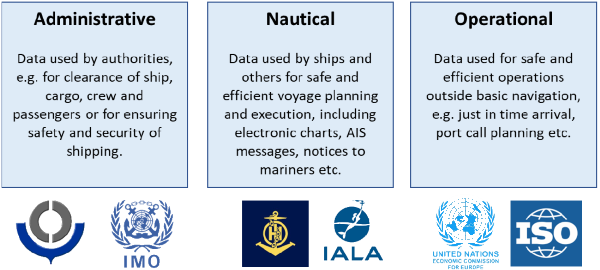
The digitalization of the maritime sector has been rapid during the last five years, and we are now also seeing a beginning convergence among specifications and standards that may pave the way for a more integrated maritime information architecture soon. Much of this convergence is centred around the IMO Compendium and the wide cooperation between stakeholders to develop an IMO Reference Data Model.
The convergence is both within specific segments of the maritime world but also across traditional boundaries between categories of information as illustrated below.

This convergence can be looked at as a step towards the maritime counterpart to the "intelligent transport system", including the supply chain perspective and integration into hinterland transport, where relevant. This is also why it was relevant to investigate these issues during the ITS World Congress, September 18th to 22nd in Los Angles.
To present some of these initiatives and to discuss the possibilities of further developments we would like to invite you to a workshop on September 21st in Los Angles. The workshop will consist of a few presentations and followed by discussions on where and how we can cooperate internationally to realize the possibilities.
This workshop was held jointly between the EU project AEGIS and the Norwegian Research Council project ISTS. It is also linked to the ongoing activity in IMO and associated organizations to develop a common reference data model (The IMO Compendium) for the maritime domain. Some more information can be obtained through the links in this paragraph.
Below you will find the program with speakers and links to the presentations, where available. The link is in the left-most column.
The maritime sector is small with only around 100 000 ships in international trade. We need to use less resources on developing proprietary and one-of-a-kind digital interfaces between our systems and use these resources to develop new and innovative digital applications. Ships and cargo owners operate all over the world and need international standards. International maritime and transport is complex and extends far into the ports and their hinterland. Better cross sector harmonization will be critical.

|
Video Keynote - Captain Ben van Scherpenzeel, International Taskforce Port Call Optimization |

|
Video Keynote - Jeppe Skovbakke Juhl, Manager Maritime Safety & Security BIMCO |
In the last years there has been good developments in harmonizing administrative data through the IMO Reference Data Model. Work started with Maritime Single Window but has also extend into Port operation (MSW) and just in time arrival (JIT) Likewise, there are interesting developments in harmonizing nautical and operational data, e.g. in reference routes for navigation and in new types of port information distribution. This involves cooperation between IHO and IMO as well as several international standards organizations.

|
Developments in Maritime Digitalization, Ørnulf Jan Rødseth, SINTEF Ocean |

| Harmonizing nautical and operational data and crossdomain re-use. Examples of values, John Morten Klingsheim, Norwegian Coastal Administration |

| Cross domain, re-use, and harmonization. Olli Soinien, Fintraffic VTS Services |

| MX SoCal & Container Ship Backup. Captain J. Kipling (Kip) Louttit, Marine Exchange |
The industry is also taking its share of the responsibility and are in many areas overcoming competitional issues to create a more integrated digital ecosystem where all parties cooperate where necessary and compete where it counts.

|
Shaping the future of Maritime Domain Awareness. Björn Coster, Market Manager - VTS, Kongsberg Norcontrol |

| Marine SDI, IHO S-100 in Support of e-Navigation and Port-Shipping Operations. Rafael Ponce Urbina, Maritime Practice Lead, ESRI |

| The Smartest First and Last Mile Wayfinding. Merja Taipaleenmäki, CEO Citynomadi |